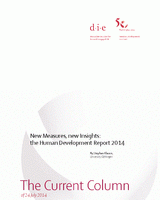New Measures, new Insights: the Human Development Report 2014
Klasen, StephanThe Current Column (2014)
Bonn: German Development Institute / Deutsches Institut für Entwicklungspolitik (DIE) (The Current Column of 24 July 2014)
Göttingen, Bonn, 24 July 2014. Today, UNDP has published its new Human Development Report. With it, it also presents its usual suite of human development indicators which have been widely used to assess progress and rank countries. It also introduces one new measure, the Gender Development Index (GDI) and it presents trends in multidimensional poverty (MPI).
Falling global inequality in human development
The flagship HDI, combining life expectancy, education, and per capita income, has changed the least. But two sensible changes were introduced: To ensure comparability of HDI values over time, the ranges for achievable values for the different dimensions were fixed and the cut-offs for the categories of low, medium, high, and very high human development were also fixed. This ensures that countries that improve their HDI can actually leave that category.
More dramatic are the changes brought about by using the recently published comparable per capita income figures, using the 2011 International Comparison of Prices results. These data, based on the most comprehensive assessment of income and prices across the world in a comparable fashion, found many developing countries to be much richer than previously believed. As a result, the HDI for many developing countries jumps, South Asia as a group moves from low to medium human development, and China jumps by 10 ranks (compared to using the old GDP figures) and now belongs to the group of high human development countries. As a result, the world looks overall much more equal in human development terms, driving by much lower global income inequality.
A sensible new gender measure with surprising results
UNDP has experimented with measures to capture gender gaps over the last 20 years. In 2010 the Gender Inequality Index (GII) was introduced. The GII measures the human development costs of inequality and considers gender gaps in health, empowerment, and the labour market. The construction of the index is highly complex, very hard to interpret, and nearly impossible to communicate in any detail to policy makers. For now, it has been retained. But UNDP added a new measure, the Gender Development Index. It calculates an HDI for females and males, and the GDI is simply the ratio of the two. It turns out that there are a number of countries (16 in all) where the female HDI is actually higher than the male HDI. In these countries, women outlive men by more than 5 years and/or have more education than men, while having earned incomes that are only slightly lower to those of men. The GDI reflects this reality of increasing heterogeneity in gender gaps across the world. And it reflects that in some parts of the world, women have surpassed men in several dimensions of human development. High GDI values can also come about due to poor human development performance of men. No wonder the transition countries are ranked highly in the GDI as men have life expectancy gaps to women of 8-10 years, often linked to poor health habits, alcoholism, and associated accidents and violence.
Interestingly, UNDP came up with new approach to ranking for the GDI as well. It is not the case that the country with the higher value of the GDI gets the top rank (it would be Estonia), but the country closest to perfect equality (a value of 1) gets ranked the best, which is Slovakia.
At the bottom end of the scale, countries such as Afghanistan, Niger, Yemen, and Pakistan have the largest gaps in human development between males and females, suffering from gaps in human development of 30-40%.
High but falling levels of Multidimensional Poverty
Since 2010, UNDP has published the Multidimensional Poverty Index. It calculates the number and share of households suffering from severe multidimensional deprivations, including health, education, and access to basic services. This year, UNDP has made some amendments to the MPI to iron out some problems in earlier versions and has started to calculate trends in multidimensional poverty. It has also promised to put all files that document the detailed calculation of the index on its website for the first time providing much needed transparency.
On the substance of the measure, the bad news is that still nearly 1.5 billion people are suffering from acute multidimensional poverty, more than the roughly 1.2 billion people living on less than a $1.25 a day. And this is just in the 91 developing countries included in the assessment; it may be closer to 2 billion people suffering from this form of deprivation. The good news is that in nearly all countries where time trends are available, multidimensional poverty is on the decline. Rwanda is the star performer here, reducing the share of people in multidimensional poverty from 87 to 71% in just five years.
In short, the numbers in this year's Human Development Report provide a mixed view of the state of human development: inequality in human development between countries falling, gender gaps differ greatly by region, and multidimensional poverty is huge, but falling. Still plenty of work to do as the world gears up to settle on the post-2015 agenda.
Prof. Stephan Klasen, Ph.D., Chair of Development Economics, University of Göttingen
